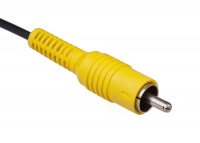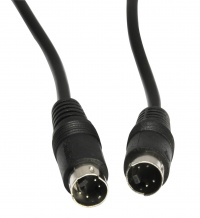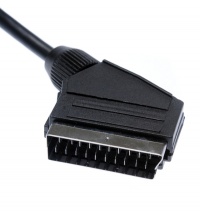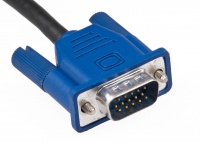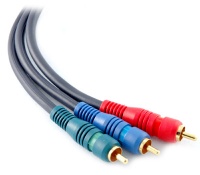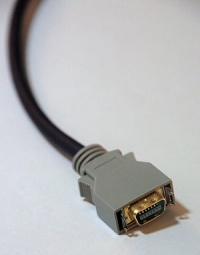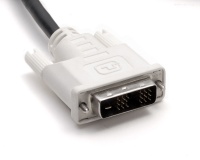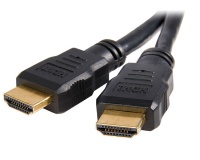Cables
Work in progress.
Contents
Analog
Radio Frequency (RF)
Supported by:- Most consoles from the 6th generation (Playstation 2 era) and earlier.
Radio Frequency cables commonly attach from an RF modulator housed internally or externally on a games console/computer to the aerial socket on a television. Because the aerial socket was standard on all TV's, even older models, RF connections were a popular way of connecting early consoles or computers to inexpensive consumer TV sets.
Picture quality:- Very poor. Though software for some consoles, such as the Atari 2600 are designed around the inherent limitations and characteristics of the poor quality RF picture and may look incorrect when using another type of connection.
Further reading:- Wikipedia - RF Modulators.
Composite
Supported by:- Virtually all consoles from the 3rd generation (Nintendo NES era) and onwards.
Composite video carries low definition video signals via a single cable. Commonly paired with one or two cables for carrying analogue audio, these connections can often be confused with the higher quality component video.
Picture quality:- Poor. Generally only used where no other alternative exists. Most consoles offering only composite output can have after-market modifications fitted for RGB or S-Video.
Further reading:- Wikipedia - Composite video.
S-Video
Supported by:- Many 3rd and 4th generation (and later) consoles and computers.
S-Video cables carry standard definition video signals via two channels: luma (luminance, intensity, "Y") and chroma (colour, "C"). The S in S-Video stands for "Separate", though it's commonly mistaken for "Super". S-Video cables offer a significant quality upgrade over composite video.
Picture quality:- Good. S-Video quality is generally pretty good, though not as good as RGB.
Further reading:- Wikipedia - S-video.
Scart
Supported by:- Most consoles/retro computers, in some capacity or other.
SCART has the distinction of being probably the most confusing of all the cable types commonly encountered by gamers. SCART cables can actually carry RGB, S-Video and composite video too. Sometimes all three at once. More unusually, they can also carry component (YPbPr) video and therefore high definition video too. SCART is also bi-directional, meaning that a SCART input cable can be different from a SCART output cable. SCART is the most common way of transmitting standard definition RGB video, the highest quality video available from retro consoles. When shopping for SCART cables, remember that to ensure that you buy RGB SCART cables if your console/computer supports them.
Picture quality:- From poor to excellent. A properly wired RGB SCART cable is the best quality connection possible on many retro consoles.
Further reading:- Wikipedia - SCART, VideogamePerfection.com - Gamers guide to SCART.
Euro Scart
Euro SCART cables are wired according to the SCART specification. These types of cable are readily available from retro gaming suppliers.
JP21
JP21 is a type of cable that looks identical to SCART but is actually wired completely differently. Gamers often encounter JP21 connectors when using Micomsoft upscalers, such as the XRGB Mini and the XRGB3. Care must be taken as attaching a standard SCART cable to a JP21 connector can cause damage. JP21 wired devices are virtually unheard of outside of Japan, so the chances of buying a JP21 cable by mistake are virtually nil.
VGA
Supported by:- Sega Dreamcast, PC's from around 1990 onwards and various other machines.
VGA cables typically carry 31khz video of at least 320x240 resolution or higher, though this is not always the case and they can carry low resolution video too. The term VGA comes from Video Graphics Array and actually refers to the first PC graphics cards that used this type of cable. A more accurate description would be D-sub 15. Most monitors/TV's with VGA inputs expect a 31khz signal and will not display a 15khz signal that retro consoles typically output. Upscalers and line doublers (such as the XRGB series) can convert from 15khz video (typically carried by SCART) into 31khz video (typically carried by VGA/D-sub 15 cables).
Picture quality:- Generally excellent.
Further reading:- Wikipedia - VGA.
DIN
Mini-DIN
Component
Supported by:- Most consoles from the 6th generation (Playstation 2 era) and onwards.
Component video usually refers to the YPbPr standard for transmitting video using three different cables. Theoretically, YPbPr component video is of a slightly lower quality than RGB. In practice however, using component video is often more desirable, since YPbPr connections support progressive scan resolutions such as 480p and above. Although there's no technical reason why SCART couldn't carry these higher resolutions too, in practice few if any consumer display sets will accept a 480p or higher signal via the SCART connector. Some displays and video processors will have component inputs for RGB connections too. In this case, there will be at least one extra connector for a sync cable.
Picture quality:- Generally excellent.
Further reading:- Wikipedia - YPbPr, VideogamePerfection.com - Gamers guide to component video.
D-Terminal
Supported by:- Most consoles from the 6th generation (Playstation 2 era) and onwards
D-Terminal cables are a Japanese standard that carry component video (YPbPr). Commonly encountered on Micomsoft upscalers, D-Terminal to component adapters are readily available.
Picture quality:- Generally excellent.
Further reading:- Wikipedia - D-Terminal.
Digital
DVI
DVI-I
DVD-D
HDMI
Supported by:- Xbox 360 (later models only), PS3, Wii-U, many PC video cards.
HDMI (High-Definition Multimedia Interface) is a compact audio/video interface for transferring uncompressed video data and compressed/uncompressed digital audio data. HDMI cables transport lossless digital data, meaning that as long as your HDMI cables meet the basic specification for the signal you are trying to send, signal quality is not dependent on cable quality.
Picture quality:- Perfect.
Further reading:- Wikipedia - HDMI, Digital Foundary vs. HDMI.

